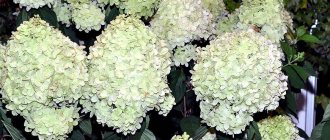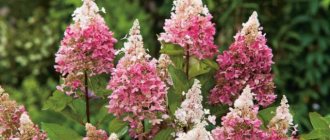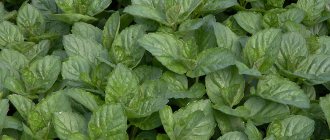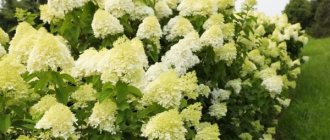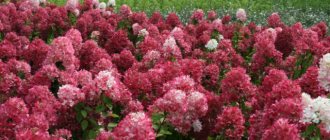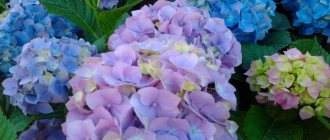Don't know how to decorate your site? Plant the best varieties of paniculata hydrangea. These luxurious plants with a huge number of beautiful varieties will not leave anyone indifferent. Gorgeous paniculate inflorescences up to 25 cm long in the shape of a wide pyramid consist of small and large flowers.
The main feature of flowering hydrangea is its ability to gradually change its color depending on the composition of the soil.
For your attention – our Top 15 beautiful varieties of paniculate hydrangea, which will feel great in the middle zone, for example, in the Moscow region. Photos and descriptions of varieties are accompanied by tips on care and recommendations for growing.
Bobo
The dwarf variety Bobo received the “Best Variety” award at a flower exhibition in Belgium in 2011. During the abundant and long flowering of this hydrangea, the color of its petals changes from white-yellow to soft pink.
Due to its low growth, Bobo hydrangea is suitable for growing in containers that can be placed on a balcony or summer terrace. It is advisable that this be a semi-shaded place, since in the bright sun the hydrangea inflorescences become smaller. It is important that the bush is protected from gusty winds.
| Purpose | Bush height (cm) | Bush width (cm) | Flowering period | Peculiarities |
| 70 | 50 | From July to September | Plant winter-hardy, but the roots young bushes needed for winter mulch | |
Hydrangea paniculata Grandiflora - planting and care for lush flowering
When to plant hydrangea, spring or autumn, timing
Hydrangea paniculata Grandiflora is planted in spring or autumn. In the spring, you need to wait until the snow melts and the top layer of the earth thaws, from which point you can start planting. It is worth noting that in the northern regions of the country, including the Urals and Siberia, planting is best done in spring days, since in the fall there is a high probability of frost occurring ahead of time.
Remember, when planting in spring, it is necessary to eliminate the threat of return frosts, therefore, in order to avoid the death of the hydrangea seedling, it is best to additionally
cover the plantings with non-woven material until a stable temperature is established.
In the Krasnodar Territory, in particular in the Kuban, as well as in other southern regions, planting is carried out in the fall due to the climatic characteristics of the area, since here the favorable period for rooting of plants is more extended. In the fall, it is necessary to comply with the condition - plant the hydrangea before the onset of stable frosts, 1-1.5 months before the intended planting in open ground.
Hydrangea paniculata Grandiflora, planting and caring for which requires attention and time from the gardener, is quite simple. Dig a hole measuring 40x40 cm , add a soil mixture consisting of two parts of humus, take the same amount of leaf soil, part river sand and peat. Mix well, make a mound and plant the seedling. The root collar of hydrangeas is not buried deep when planting. After planting, you need to mulch the space around the plant with peat or pine bark, needles, so that they acidify the soil during the process of overheating.
When planting, you cannot use dolomite flour or lime; it is also not advisable to apply organic fertilizers, which will neutralize the acidic soil. Hydrangeas should grow in acidic soils; if the soil has a neutral PH level, it is recommended to acidify it (1 teaspoon of citric acid per bucket of water), and then do this regularly. Otherwise, the plants will not correspond to the declared characteristics (the color of the flowers may be paler, the leaves will suffer from chlorosis).
Hydrangea care - pruning
Pruning of the Grandiflora hydrangea is carried out with the onset of spring (April-May), but before the sap flows. If sap flow has already begun, prune if necessary when the leaves appear. Also here you need to take into account your own preferences, what you ultimately want to achieve from the shrub. In autumn, only faded buds are cut off.
To obtain more lush inflorescences, from one to three pairs of buds are left on the growths.
You can increase the number of inflorescences if
you cut off the growths by only the same 2-3 buds , but then the buds will be smaller. Experienced gardeners carry out more severe pruning; if you are a beginner, try shortening a little to understand from your own experience which pruning suits you best.
paniculata Hydrangea Grandiflora - in the photo
Hydrangea Grandiflora blooms on the shoots of the current year , so carefully monitor the branches that you cut, otherwise you will deprive yourself of the opportunity to see a beautiful lush bush. Another feature of the paniculate hydrangea Grandiflora is its large, heavy inflorescences , under the weight of which the shoots bend strongly and almost lie on the ground. To solve this problem, many consider it necessary to form a bush in the form of a tree over several years. Other experienced summer residents suggest installing bamboo supports and tightly tying the main shoots to them, so that within a few years they will get stronger and the problem will be solved.
In general, it is worth noting that many gardeners do not prune their hydrangeas at all, and, according to reviews, the bushes are lush and always bloom profusely.
Sheltering hydrangeas for the winter
Panicle hydrangea Vanilla Fraze is a prominent representative of this type of plant and has the same requirements for fertilizers, just like Grandiflora, so we will not dwell on feeding in detail, but will move on to covering the Grandiflora hydrangea for the winter.
Although the plant is frost-resistant, many gardeners and summer residents are of the opinion that it is better to cover, especially young hydrangea. So what needs to be done:
- carry out sanitary pruning in the fall, remove all faded inflorescences and branches growing inside the bush, thickening it;
- covering must be carried out in dry weather , you don’t have to wait for the onset of stable frosts, hydrangea does not germinate in comparison with roses, so you can wrap it earlier, but according to the rules;
- inspect the ground around the base of the bush; if it is damp, add dry garden soil to reduce the humidity under the shelter; in any case, the space should be mulched with a good layer of peat or humus;
- pin the shoots to the ground with iron staples;
- on top , create a frame of boards and boxes so that they stand well and do not fall onto the plants under the weight of snow;
- cover the frame on top with spruce branches, lutrasil, burlap or other breathable material and lay the last layer of black plastic film or roofing felt. It is important that the shelter does not allow light to pass through, otherwise, during thaws, there will be a greenhouse inside, which cannot be allowed;
- Until cold weather sets in and snow falls, leave openings on the sides of the structure for ventilation; when cold weather sets in, close them.
In winter, do not clear the snow, but make sure that the structure does not break under the weight. In the spring, there is no need to clear the snow; as soon as it melts, start airing.
Here is this Hydrangea paniculata Grandiflora, planting and caring for which may seem difficult to some, but in reality there is not much hassle, you just need to buy and plant...
Phantom
The variety is highly valued for its lush flowering and the unique honey aroma that the beautiful flowers emit. In summer, the inflorescences are light cream, and by autumn they become pinkish, while their tops turn yellow. The petals of this plant are slightly different from other hydrangeas: they are slightly elongated and are not located so closely to each other.
| Purpose | Bush height (cm) | Bush width (cm) | Flowering period | Peculiarities |
| 200 | 200 | From July to September | In the middle lane young plants may freeze so their cover layer of mulch | |
Description of the variety
Hydrangea paniculata Grandiflora is a tall shrub of German selection, reaching a height of 2-2.5 meters and a width of up to 3 meters. It belongs to garden crops with a rapid growth rate; it grows up to 25-30 cm per year. Young shoots with slight pubescence become naked in adulthood. The color of the bark changes from red to brown, and peeling occurs over time. The root system is branched but shallow.
The leaves are rough, elliptical in shape, and large in size. The apex is pointed, the edges are jagged. The color is dark green and practically does not change in autumn. Small flowers are collected in cone-shaped inflorescences-panicles with a diameter of up to 20-25 cm, the shades of which change as they grow from white and cream to pink and red-green. Characterized by late flowering.
Advice! It is contraindicated to plant bushes on calcareous soils.
Hydrangea Grandiflora is highly frost-resistant and does not tolerate drought or direct sunlight. It is preferable to plant in partial shade, on light loams with medium or high acidity. Afraid of drafts and stagnant water. The variety adapts well to urban environments and is resistant to gas and air pollution. The variety is noted for its longevity, the shrubs grow up to 40 years, and are resistant to diseases and pests. The height of Grandiflora hydrangea depends on the intensity of care and climatic conditions.
Reproduction
Hydrangea Grandiflora is propagated by cuttings and offsets . It’s very easy to get them, having at least one such plant in your garden, you can do without purchasing if you want to plant a few more bushes.
- For layering, which is taken in the spring, you need to bend 1-2 lower branches to the ground, secure them and cover them with soil. Be sure to water these branches regularly. At the end of the season, when shoots appear, they can be carefully separated and planted in another place.
- For cuttings, in mid-summer the upper young shoots are carefully cut off. You need to leave a few leaves, place the shoots 4-5 centimeters into the soil, and cover with a glass jar. With the appearance of roots, the cuttings are ready for transplanting.
Selection of location and conditions of detention
Hydrangea is a fairly light-loving plant, but placing it in direct sunlight is not recommended. This will significantly impair flowering and decorativeness. You need to choose an area with diffused light. The plant does not tolerate drafts and cold winds, so it is better to plant bushes along the walls of buildings or along fences, especially since gas pollution from highways does not harm hydrangea.
Since hydrangea is distinguished by its superficial root system, it is not advisable to plant it next to fruit trees with strong roots. They will take life-giving moisture and nutrients from the hydrangea.
Despite the fact that hydrangea paniculata Grandiflora is very moisture-loving, it can easily tolerate periods of drought, but this threatens with poor flowering. In humid climates, even watering is not required during the rainy season.
The soil for hydrangea should be fertile, loose and acidic with a pH of 4-6.5. This plant does not tolerate the addition of lime, ash and chalk. The composition of the soil for the best flowering of hydrangea is 2 parts of turf and peat and 1 part of humus and sand. It is advisable to add pine needles to this mixture.
Disease and pest control
This variety of hydrangea is most susceptible to diseases such as powdery mildew and garden aphids. To combat them, well-proven drugs are used - Fundazol, Okihom and their various analogues. Spraying with these fungicides should be done before flowering begins according to the attached instructions.
You can also use folk remedies - a solution of garlic tincture and laundry soap in a 5/1 ratio. There are special preparations to combat aphids. Spraying for preventive purposes should be carried out once every two weeks.
Features of care in winter
Hydrangea Grandiflora paniculata is a fairly frost-resistant plant that can withstand frosts up to 30 degrees. In the southern regions of Russia, you can do without covering it for the winter. But in temperate latitudes during severe winters, it is better to perform these simple actions:
- After flowering ends, trim off dried inflorescences.
- Mulch the soil around the bush.
- Bend the branches to the ground.
- Cover them with a thick layer of fallen leaves on top.
- Cover everything from above with a wooden box or slate.
- If the bush is in the shape of a tree, then you need to wrap it in old burlap and tie it with wire.
